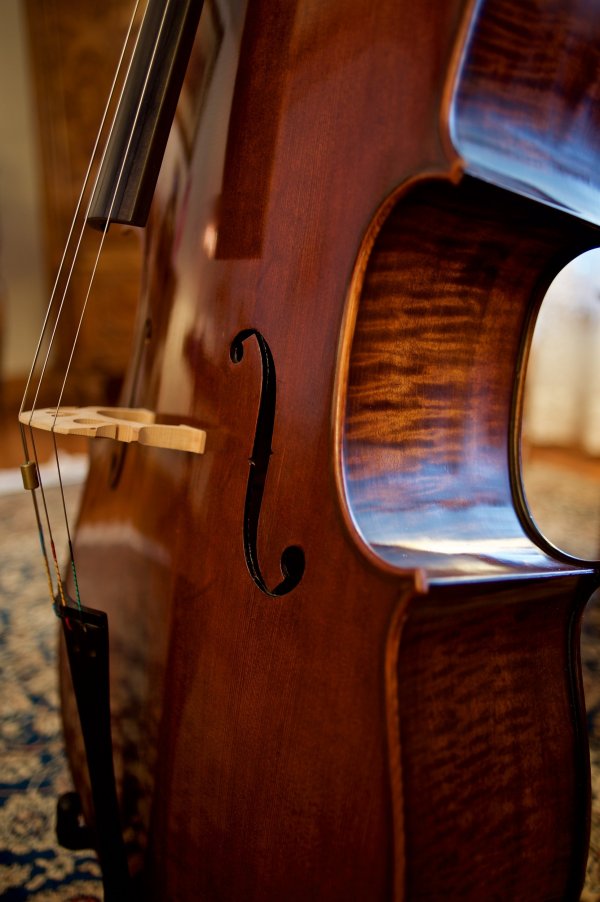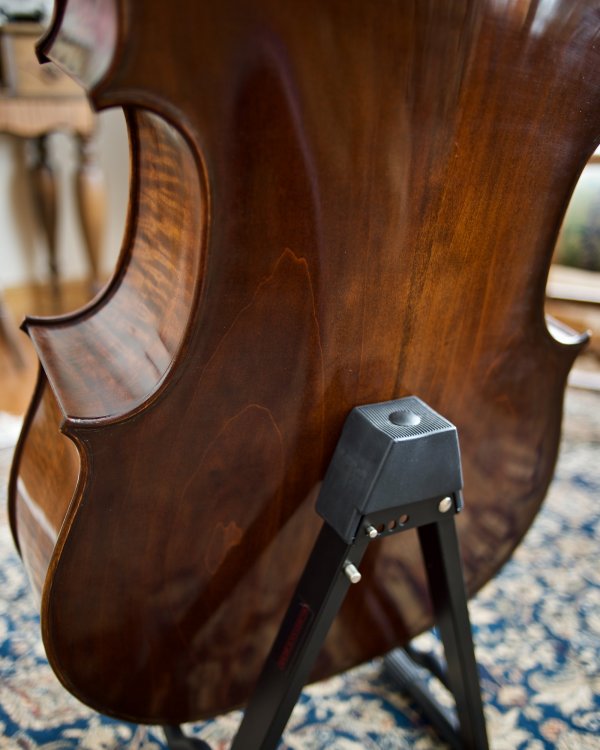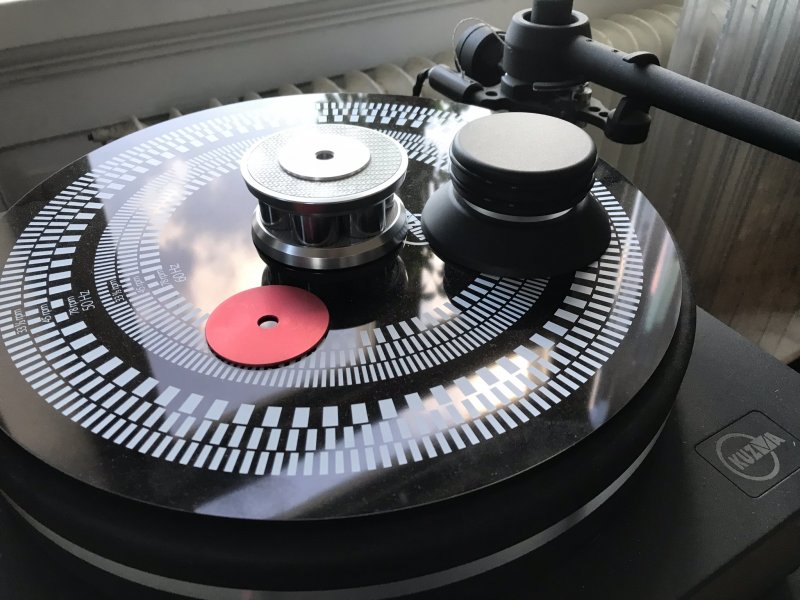The eagle has landed....a slightly used Kuzma Stabi R from Steve at SOS Audio in New Hampshire...very nice guy to deal with and super helpful...
I've been a full on 100% Idler Wheel guy for 21 years. My current idler is Garrard 401 that has been modded and sounds very "hifi-modern"....but it keeps needing work and I am ready to stop messing with it. So I got a Kuzma belt drive TANK, a set it and forget it type of table. The plan at the moment is keep both but I am not married to that idea. The Kuzma does have the attraction of easily adding another tonearm if I feel so inclined to go that route.
After listening to the Kuzma I was very surprised that the two tables sound more similar than different. Extremely similar, I was shocked but also glad, it reinforced that I was not crazy to have listened to a "vintage" table for 20 years. The modded Garrard is an real audiophile piece of gear. Both tables are very big and bold sounding, both have killer dynamics and drive. Both sound almost identical with the same arm and cartridge. However there are differences as one would expect. The Kuzma has that belt drive ease, even with the dynamics and drive, it's there. That slightly rounded edge to the piano and bass that the Garrard does not have. A piano chord can cut like a knife on a Garrard...a little less so on the Kuzma. What I don't hear with the Kuzma is fatigue so far I can just listen and listen and listen. The Garrard can overwhelm sometimes with certain records and get fatiguing and slightly harsh, too in your face and too ruthless with poor recordings. More records sound ok on the Kuzma than the Garrard. On the Garrard they either sound amazing or not so hot. The Kuzma kinda sorts everything out a little more evenhandedly and makes more records more enjoyable. This is something I remember about my last belt drive and something that has been sorely missed. There is more inner detail with the Kuzma, that's what they say with belt drives and I heard it in spades. It took several records to hear it but when I started to notice it I could not NOT hear it. Air, space around a vocalist, the movement on a bass string, just gobs of micro dynamics that I totally miss with the Garrard. It was a fun night!
So thats round one. They both do many similar things but they both do some things differently. I very much like what I am hearing from the Kuzma though. Very eager to keep listening.
Hi all,
I’m finding minimal time for forum participation these days, and I recently became aware of
@Davehg's post #32 & 70 (thanks for the kind words, Dave!). I’ll try to address the various questions & comments in this thread in a few installments.
Caveat (do I really need to say this?) – these are a reflection of my biases, but I’ll try to lay them out clearly, and not represent them as absolutes.
The first post that jumped out at me was @kozzmo’s post #14 (Garrard 401 vs. Stabi R).
I share your observations about the similarities (
@kozzmo). I found that with each improvement we made in our own belt-driven designs, that the distinction between belt and idler narrowed. Kuzma’s design approach and similarities to our philosophy (stiff belts, high rpm, brushless DC motors, no suspension) is what attracted me to the Stabi R as a cost-effective option to our turntables.
So in short, I’m not surprised that you’re hearing far more similarities than differences between your 401 and Stabi R. They're both very good.
Regarding your comment:
More records sound ok on the Kuzma than the Garrard. On the Garrard they either sound amazing or not so hot.
You bring up a point that’s lost on many audiophiles. We are tortured lot, in our quest for the magic beans.
I always prioritize searching for the sweet spot between resolution and “listenability”. I frequently write about how a system can either expand or contract your record collection – the number of recordings you actually want to listen to.
This may be one of the most challenging pitfalls to navigate as an audiophile – especially if we value the talents of a virtuoso. It’s their nuance and technique that distinguishes them from the “merely competent” musician, and there’s a parallel to this in the playback side of the recording chain. Low-resolution systems need not apply.
The challenge lies in the fatigue factor associated with many “high resolution” systems. I put that in quotes because I’ve found all too many components masquerade as high resolution. A significant number of them are like a photograph that’s been over-sharpened and over-saturated in Photoshop. This “wow” effect (either in hi-fi reproduction or photographs) can be quite pleasant, and it may be what you’re after … or not. I’m not here to dictate what’s fun for you.
There are all too many ways to ruin your musical enjoyment, but the results are always the same: you find yourself listening to fewer of your recordings. You’re in search of the next tweak or component to take you to the promised land.
At one point, I owned speakers based on full-range drivers, and over time, I stopped listening to large, musically “dense” works. These speakers were remarkable at rendering small ensembles, and this clouded my judgement. It took me years after selling them to return to enjoying the neglected 1/3 of my record collection. This isn’t a statement about all full-range drivers.
This concept of leading/trailing edge transients is another tricky one, in much the way that we find ourselves being enamored of spatial rendition (soundstage).
I like your use of the term “rounding effect”, and there’s a fine line between ringing which can manifest as an “edge sharpening” effect on the leading and trailing edges of the transient, and one that’s better controlled – one that sounds just a bit less immediate.
Even this is tricky, and there’s no right answer. As a listener, the only thing we can do is to evaluate based on long-term listening - which component more effectively delivers the smiles, tears and the physical responses we have to music. Which one keeps us up later past our bedtime.
I’ll end this first installment with an anecdote. Pete Millet performed a demonstration at the 2004 European Triodfest: “The Sound of Distortion” -
http://www.pmillett.com/etf_sod.htm
In the downloadable PowerPoint presentation linked to above, he describes how he created a circuit to alter the harmonic profile of the playback signal, adding or subtracting odd-order harmonics.
In general, the participants at the ‘fest preferred a slight bit of added harmonics. Add a bit more, and the sound became overly aggressive and fatiguing. A bit less, and the presentation became too bland.
As similar as we are as a species, we all “process” music differently. While I think that we all subscribe to the “just enough, but not too much” principle, we all have a different idea of what “just enough” is.
It’s like the couch potato who secretes enough dopamine by watching an adventure movie, vs. the adventure seeker who requires a much more challenging environment to achieve the same result.
As Pete says, there’s no right answer for everyone. I'll try to work through this thread in the coming days.
… Thom


















